Exposition of research
Problem addressed and the goal of the research
As we argued above, the analysis of the phenomenon of Russian philological culture
of the 1920s suffers from the same drawback that is typical for historical research in the humanities as a whole – it remains mostly focused on individual authors, works, or relations. At the same time further progress in understanding Russian intellectual revolution
requires an approach that goes beyond the study of individual authors, texts motifs, connections, or communities, in order to take into account the multiplicity and complexity of the relations between the texts and between the actors, which acted as nodes in a wide network, and to make evident the variety and density of the context. We need to examine systematically not isolated relations, but their interference and juxtaposition, to follow their evolution, and to assess their intensity and impact. Such analyses immediately hit the so-called dimensionality curse
problem – large studies quickly become unfeasible due to the number of connections to consider and the complexity of the resulting networks of citations, concepts, and ideas.
Our main goal is to elaborate a proper knowledge representation enabling scientific collaboration, to complement close reading with distant reading, to facilitate navigation in the scholarly literature, to assure the linking between classical
texts and the large international scholarship focused on them, and to provide effective visualization. We are exploring the network of relations both within and between three key communities of the philological milieu of the period: (i) the Formalists, (ii) Nikolaï Marr and his school, and (iii) Mikhaïl Bakhtin and his circle, approaching them through the optics of two important philological romans à clef of the period, Veniamin Kaverin’s The Troublemaker and Konstantin Vaginov’s The Goat Song.
Methodology
We achieved the goal outlined above, whilst pursuing the following objectives (partly achieved at the moment):
-
To prepare a representative corpus of primary texts, relevant for better understanding of these novels; retrace thematic, typological, institutional, private and other influences, borrowings, impacts and other types of transfer; convert them into digital form;
-
To build a collection of secondary literature focused on primary texts; Structure this collection by interconnecting it with concepts and objects in primary texts; Ensure maximal possible completeness of the collection
-
To retrace a multiplicity and variety of relations between actors to follow their evolution and measure their intensity and impact of their interplay;
-
To enrich primary texts with a network of annotations (both related to the whole text and ad locum), building upon existing research texts and using both automated tools of semantic analysis and manual curation.
-
To adapt the nanopublications approach (that has been already successfully applied in the natural sciences), to the new domain.
Preparation of the corpus
The perspective of our team on the theoretical, philological atmosphere of the 1920s is that of the fiction, or rather of a particular genre, roman à clef, that underwent an apparent revival during this period. Both works that we adopt as starting points are also philological novels
. Each of them is a specific literary speech-act
and at the same time a precious testimony of cultural and theoretical events, and a living proof of an intense exchange between literates and scholars within a common philological
context. They quote (but also elucidate, advertise, mock or parody) numerous theses, ideas and theories of contemporary philosophers, literary theoreticians, critics, linguists, etc. In fact, fiction and nonfiction, practice and theory shed a reciprocal light on each other. To make it evident, a large amount of secondary literature should be brought to the primary (fiction or nonfiction) text.
has already demonstrated that these two novels give quite a seminal access to the philological context of the period and encompass a big variety of relations connecting their personages (and persons who inspired them). Personal, professional, cultural, generational, conceptual, and other relations are densely interwoven in Konstantin Vaginov’s roman à clef The Goat Song (1928) and his three further texts, Works and Days of Svistonov, Bambocciada & Harpagoniada (1929-34), the whole is often considered as one metatext. Various problems – like unity of science (and of the world), literary vs. everyday language, prose vs. poetry, conscious vs. unconscious, inner form of the word
, nature of the sign, methodology of humanitarian knowledge – are discussed within a very interdisciplinary (and very imaginary
) community, which will later be known as the Bakhtin Circle
. We consider Vaginov’s text with and through the multiplicity of references to the real and dubious inspirations of the novel (L. Pumpianskij, M. Bakhtin, P. Medvedev, P. Luknickij, M. Yudina, M. Kagan) and to various philological and cultural ideas, such as the famous Bakhtin’s concepts of carnival, menipea and dialogue, life vs. art, the unconscious, social aspects of language, and other echos of the contemporary language policy, etc.
The connections of the Vaginov’s novel are presented on its page in VicoGlossia:
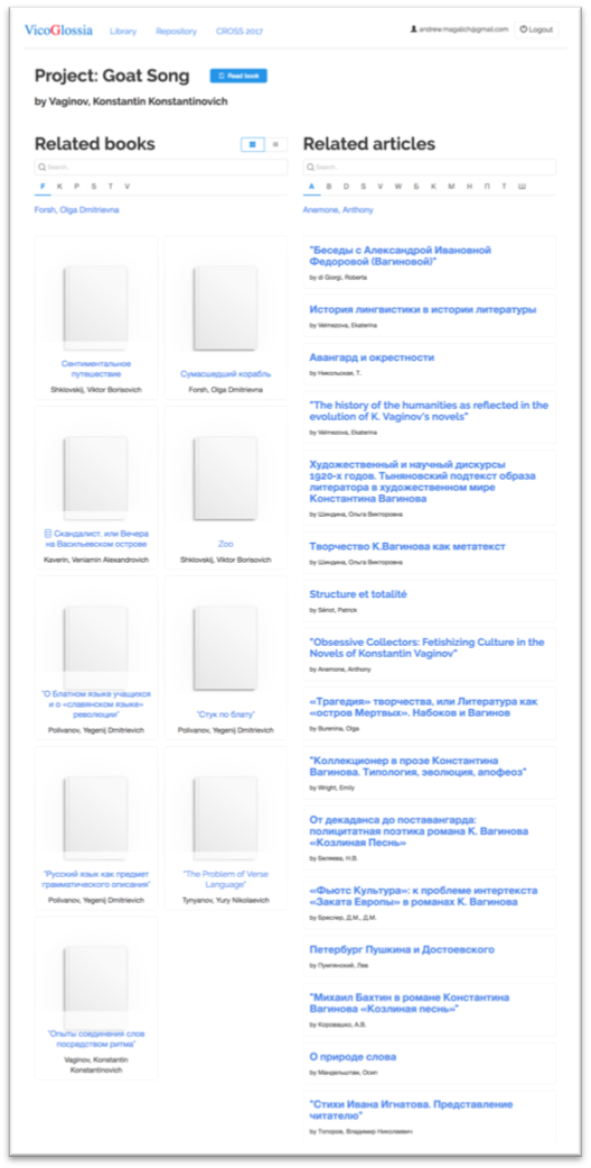
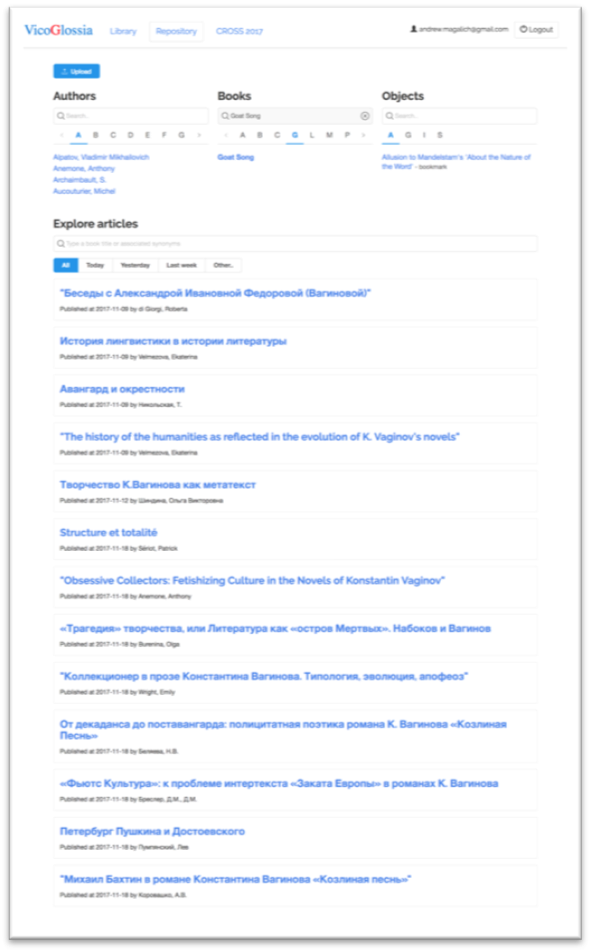
Veniamin Kaverin’s novel The Troublemaker (Scandalist), or Evenings on Vasilievsky Island
(1928), also both a philological novel
and a roman à clef, can be understood only in the context of professional communication
and intertextual battle of the author with the key figure of the intellectual scene of the period, V. Shklovsky, the inspiration of the principal character, and consequently with the whole Formalist movement. This important literary testimony of intense linguistic and literary debates sets up numerous cultural and linguistic issues: relations between university and non-academic world; conflicts between old and new theories of language, between philologi vs lingvisty (resp. Anciens vs Modernes), thus imbrications of generational and philological debates; the social nature of language; questions of language policy and planning (with evident allusions to O. Vinokur, L. Yakubinskij); the heritage of A. Potebnja, etc. The novel is also an homage paid to E. Polivanov whom Kaverin admired all his life. Besides, N. Marr’s new doctrine of the language
is present in the novel, amalgamated with Polivanov’s views. In a tacit way, the outset of de Saussure’s glory is also to be retraced (The Course in general linguistics will only be translated (by A. Sukhotin), commented and edited in 1933 by R. Shor, another shadow figure of the novel, but de Saussure’s influence and controversies around started earlier).
See below the collection related to The Troublemaker
.
These two novels are intertextually related to a huge number of other texts, ideas, and debates (mostly the Formalists and Marr’s school, for V. Kaverin; the Bakhtin circle, the Akmeists, for K. Vaginov). Furthermore, these novels can be regarded as performative responses to certain discourses of the mid-1920s (e.g. The Troublemaker is Kaverin’s credo in the debates on “sujet prose”). Finally, these novels have engendered certain texts – critics, polemics, authors’ answers to them – also to be discovered and to be included in the corpus. Some of these connections (mostly linguistic ones) have been analysed in and other studies, many other relations remain to be established and explored. We adopt here the iterative approach – we study and systematize research literature, extracting new connections, and this way completing the corpus.
Although this work is not finished yet, the initial collection can be found at the screen shot below.
We assembled а collection of texts that form a community
where the interconnections between texts within this collection are tighter than with the other texts. Already this minimal collection allows to demonstrate the viability of our approach. In the course of the constitution of the corpus, all fiction and nonfiction works pertinent for understanding or explicitation of novels – and vice versa – have been stored in the VicoGlossia database according to the TEI guidelines. Where necessary, the original Russian texts, as well as their translations into English, French, and German are digitized. We edit and curate the texts according to the appropriate philological standards (with canonical pagination, meta-data, variance, etc). The VicoGlossia platform allows to align translations automatically at the sentence level and upload facsimiles (when available).
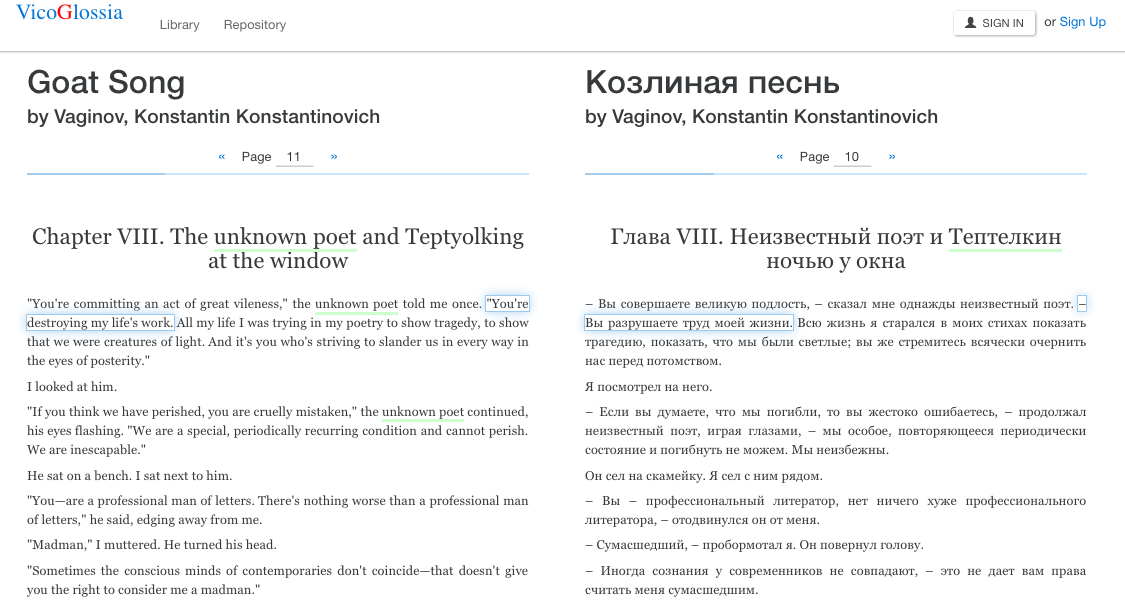
Structured repository of secondary literature
We started the collection of secondary literature from the bibliography of and expanded it in conjunction with primary texts, in order to present the history of debates and cartography of interpretations concerning Russian philology of the 1920s. The full-text collection is being formed by downloading available texts, then by scanning and digitizing further publications. Using automated tools of text analysis, available in the VicoGlossia platform, we identify main named entities (persons, places), periods of time, events, etc., and we build a consistent graph representing relations between these entities and multiple semantic links between primary and secondary texts. We curate and extend this data manually, producing a high-quality structured bibliography of the field. As a result, research literature is connected in multiple ways with primary texts through text elements and comments to them, named entities, and document metadata: citations are identified and linked to corresponding texts; personalia and events are linked throughout the texts with biographies and/or historical references. Where appropriate, connections are established across available translations and editions. All annotations are available for future additions and amendments. Modern initially digitized secondary literature is Zotero-compatible, and linked to Academia, Google Scholar, and other resources. It is structured in the Resource Description and Access (RDA) standard, allowing research from any metadata or any combination of them.
Retracing connections, assessment of the interference of relations
Scholar and literary works of the period were interwoven in various relations of intertextuality , or transtextuality, and both novels offer a rather complete array of them. Some authors, in their texts, were not that remote, as one might pretend (Kaverin / Vaginov). Some texts, considered as pioneering, have important predecessors (allegedly revolutionary
in linguistics, Marr was deeply rooted in the context of the epoch: ). Relations could be not only connective
, but also disruptive
: some disciples’ and followers’
texts were loyal to their mentors only on the surface (Marr / Frejdenberg: , ; Marr / Shor: ); some insights could be produced through productive misunderstanding
(erroneous ontological character of the phoneme
in Eurasians, that led to the phonology, ); some ideas were more successful
when transplanted onto other field (theory of hybridisation transferred from linguistics to analysis of ethnographic facts and other types of transfers).
But relations to take into account were by far not only textual. We have already established following types of relations (connections followed by transfers):
-
conceptual: ideas or concepts discussed during the period (language vs. literature; prose vs. poetry;
holistic paradigm
of knowledge;new man
resp.new reader
; role of subject/sujet; art as ensemble of devices/techniques; (Marr’s)popular linguistics
); -
institutional-collaborative: a variety of communities and institutions with various degree of freedom and coerciveness for their members: Bakhtin’s Circle, Serapion Brothers, M. Yudina’s salon, OPOYaZ, Moscow Linguistic Circle, LEF…);
-
personal: various personal (or even family: Pasternak / Frejdenberg, Kaverin / Tynjanov) relations might be important for the circulation of ideas;
-
disciplinary: scientific schools and teacher-student continuity (Marr & Piotrovskij, Meshchaninov, Frejdenberg; Polivanov & Kaverin) in spite of intense
negotiation phase
about the borders between scientific disciplines; -
generational: many disciples combined debt and criticism towards their mentors (Baudouin de Courtenay, Shklovsky or Marr);
-
professional-communicative: various forms of
speech acts
articulating the professional communication: manifests, book reviews, letters, dialogues/quarrels by means of literary texts, play of reciprocal dedications, romans à clef, etc.;
Some relations were marked by clearly disruptive or transgressive features:
-
competitive-agonal: some actors were connected through their opposition (holistic paradigm vs. mechanistic paradigm; Marr / Polivanov).
-
inter- and transdisciplinary: transgressions of discipline borders (importance of
milieu
: Bakhtin / Lysenko / Mandelstam, quest of the language of cinema: Eizenshtejn / Marr / Vygotskij / Lurija, holistic paradigm: Marr / Vernadskij / Berg) -
inter-genre: intense quest of genre renewal, letters/treatises/novels in Formalists, theoretical diary in L. Ginzburg etc.
-
inter-communitarian: relations between communities and institutions (Moscow Linguistic Circle & GAKhN), continuity between them (MLC & Prague linguistic circle); simultaneous membership or conversion from one to another (Shklovskij, Vaginov).
-
international and -lingual: Husserl vs. Shpet and other phenomenologists; Saussure vs. Shor and other linguists; Humboldt / Potebnia / Shklovskij; Meillet / Marr; Cassirer / Frank-Kameneckij / Frejdenberg; in general neokantianism and its Russian reception.
-
intermedial: fruitful passages literature / cinema in Shklovskij, Tynjanov et al.; literature / theatre in Bulgakov; arts / literature in O. Forsh.
-
real-fictional: Shklovskij, Polivanov, Pumpianskij et al. as inspirations of fictional representations.
-
artistic-scientific: exchange between literature and literary science (Khlebnikov / Jakobson, Shklovskij as both artist and scholar), but also in other domains (Vygotskij / Mandelstam).
-
genetic-receptive: sometimes reception of a work is radically different from the context of its creation (Bakhtin’s
rediscovery
and hisproductive
mis-evaluations in Europe).
All these relations evolved in time and change their importance. Besides, each of them did not exist separately; the interplay between them was not an exception but a rule, and they did not only coexist, but impacted each other, modified, augmented, or diminished the common effect. To follow their evolution, to examine their interference, and to assess their intensity, their mutual and joint impact we use digital tools offered the VicoGlossia platform. In a methodological sense, the work must result in the discovery of numerous gaps which were left without due attention during the work conducted with more traditional
methods . E.g., speaking in his The Troublemaker about A. Meillet, V. Kaverin evidently meant another linguist, F. de Saussure: it was he (and not Meillet) who failed to write a book on general linguistics
, that is, the famous Course in general linguistics. This (conscious?) substitution (Saussure instead of Meillet) allows to analyze a whole cluster of topics and problems connected with the reception of the Course in Russia. Even if the early stages of its reception seem to have been already well studied (by M. Chudakova, E. Toddes, C. Genty-Depretto, I. Ageeva-Tylkowski, I. Ivanova), no detailed research has been done yet about very rich comments provided by R. Shor to her first Russian edition of the Course. We are translating these comments in English and French, commenting and analyzing them through the prism of the whole context of the studied epoch from a historico-epistemological point of view, starting with the names and research problems explicitly mentioned in these comments. Additionally, this research constitutes another step forward in the study of the intellectual heritage of R. Shor, the study which has only recently begun in a detailed way and future potential directions of which have already been listed. Further gaps and lacunas to fill will become manifest in the course of our research.
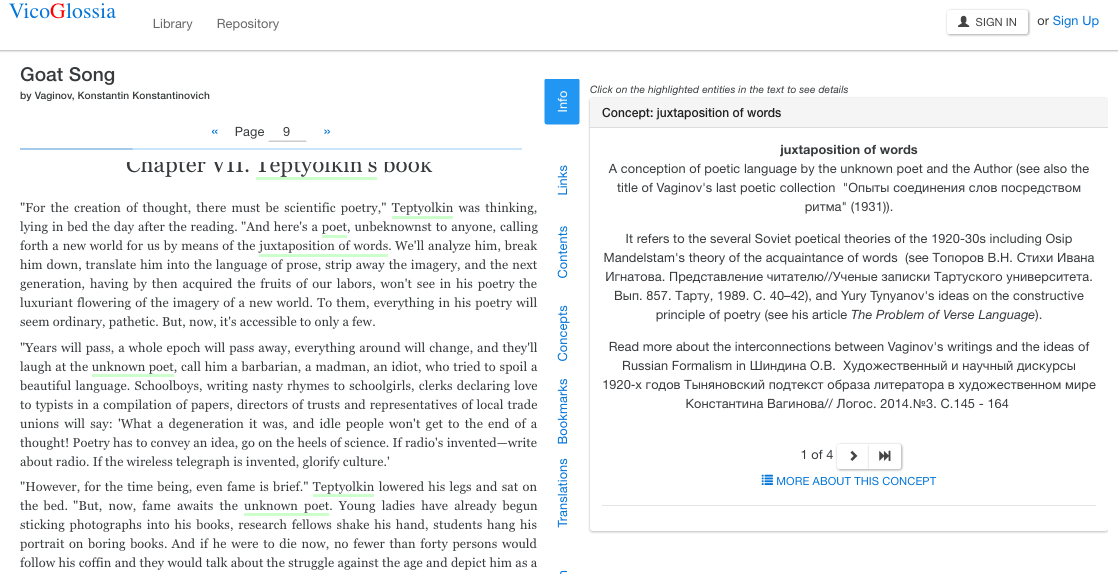
Annotation for semantic and contextual network
We supply primary texts with a variety of general and ad locum annotations referring to secondary literature or to respective passages in it. The annotations can concern lexical, phrasal, sub- and supra-phrasal text units, and are of different type: biographic, historical, theoretical, treating influence and impact, etc. This information is structured according to the following scheme.
Metadata & Explanatory notes for each work
Metadata
-
Author
-
Title
-
Genre / Domain
-
Further features/tags
-
Language
-
Dates of creation
-
Date of publication
-
Volume (number of characters)
-
Editions: year, place, number of copies
-
Bibliometric indicators
Explanatory notes
-
Textuality
-
Material evidences (eventual available documentary forms (facsimilé of manuscripts, of the 1st edition)
-
Principal textual variants
-
Critical editions of the text
-
Existing digitized versions
-
Reason of the choice of the given variant
-
Design (format, handwriting, typography, etc.)
-
-
Contextuality
-
Chronology of the creation
-
Textual genetics (composition, revision, production, censorship, etc.)
-
Evidences (personal diary, letters, memoirs of contemporaries)
-
Social, political and intellectual milieu.
-
-
Intratextuality
-
Linguistic analysis (lexique, style, syntax, etc.)
-
Literary (genre, narrative or poetological) analysis
-
Fictional chronology
-
Structure/composition
-
Dramatic framework
-
Principal personages
-
Other personages
-
Central problematic
-
Motives, topics, themata
-
Ideological analysis
-
Cultural analysis
-
Tradition vs. novelty of the work
-
Peculiarities of the work
-
Literary (philosophical, political, scientific, etc.) appraisal of the work
-
-
Intertextuality
-
a. Relations with the author’s other works
-
Influence or inspiration (positive or negative) by other authors’ works (past)
-
Interconnections with contemporaries (present)
-
Interdisciplinarity – intermediality
-
Impact on other authors’ works (future)
-
Translations
-
Adaptations (literary abridgements, adaptations in theatre, cinema, radio, music, dance, comics, etc.)
-
-
Interpretation
-
Self-evaluation
-
First reactions (reception by contemporaries)
-
History of interpretation
-
Current trends in interpretation of the work
-
Current controversies
-
Adapting the nanopublications approach
As outlined above, an understanding of the intricate relations and interactions between persons, texts, places, events, and of the interferences of such relations is crucial for understanding the phenomenon of Russian philological culture in the 1920s. To make full use of the extracted information concerning it, more than just free-form text is needed; in particular, it is important to document its provenance. Scholars have an opportunity to contest a result, to propose their hypothesis without erasing the contested one; the solution may come later, when new information becomes available. It is possible to integrate the results of automatic processing, e.g., named entity extraction, as preliminary annotation that can be validated later by researchers.
Our approach to this issue is to uniformly represent annotations as self-contained entities on the Semantic Web, as inspired by nanopublications, which are already successfully being used in bioinformatics. Within our platform, we adapt and extend nanopublications for applications in the humanities, in particular for the representation of intertextual relationships. Our work in this field thus concerns three main areas: (I) the extension of the nanopublications concept to the needs of humanities research. We build on the work by and , but handling uncertainty and vagueness which play a much bigger role in the humanities than in natural sciences and is therefore be an important research topic; in this particular area, ORCA (Ontology of Reasoning, Certainty and Attribution) could be a good starting point, but needs to be extended; (ii) the development of ontologies and controlled vocabularies required for formally representing intertextual references and scholars’ findings about them; this research builds on existing ontologies from other fields, such as the FaBiO, CiTO , and SAWS ontologies mentioned above; (iii) the integration of tools necessary for collaboratively creating, browsing, searching, and generally managing annotations represented as nanopublications into the VicoGlossia platform. Since nanopublications are based on the same Semantic Web technologies as VicoGlossia (in particular, RDF), it can seamlessly integrate them into the system.
Implementation of the toolkit
The current version of the VicoGlossia platform presents a web application that consists of the library of primary texts, repository of secondary literature and tools that allow users of the platform to comfortably navigate, read and annotate the texts. The main approach to visualization of the intertextual connections chosen in VicoGlossia is the integration of the semantic links directly into the reading flow: additional information and links appear directly in text, allowing for natural discovery as well as directed search based on the contents. We believe this implementation is the most suited both for the public willing to put the books into broader context and for the scholars that need to examine large corpuses of literature and generally have a specific interest in doing so.
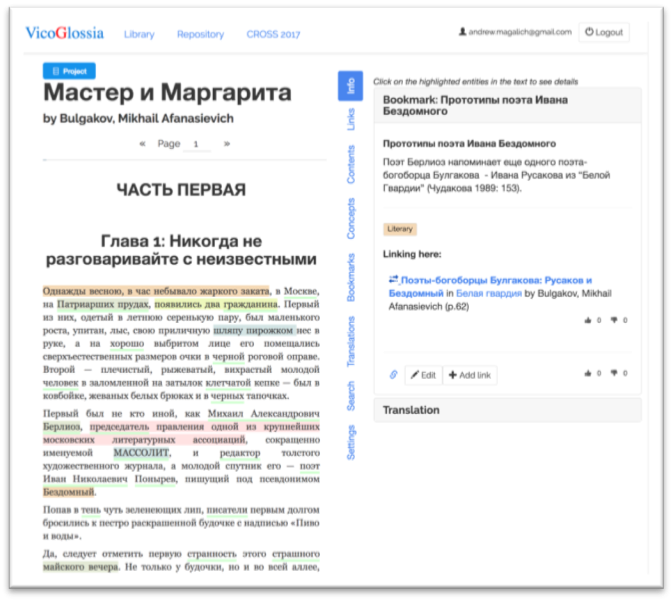
Nanopublications are implemented as annotations attached to the entities (characters, locations, specific recurring words) or arbitrary chunks of the text (events, phrases). Each annotation is a virtual post-it note containing necessary information — explanation or description, categorization, information about author and links through which the text is embedded into the intertextual network. A number of natural language processing algorithms are used to create guesses for entities (using named entity recognition, keyphrase extraction) as well as automatically align the translations and editions of texts for parallel examination (using statistical dictionary- and machine translation-based algorithms).
Users contribute by uploading the primary and secondary texts, supplying metadata and, most importantly, by creating nanopublications inside the system. VicoGlossia is a crowdsourcing platform where scholars are motivated to contribute by uploading and linking their own research. Their well-interlinked studies become immediately visible in connection to the primary texts and other publications.